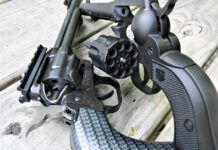Aserious rifle benchrest shooter will go through a course of fire with a single case, reloading it on the firing line. The objective is to assure repeatable accuracy in a load carefully worked up to shoot groups measured in thousandths of an inch. Among the things the shooter eliminates by repeatedly using the same brass is the deviation in ballistics caused by internal case volume (ICV).
Even when a box of brass comes from the same lot and manufacturer, there’s no way to be certain of their individual ICV without taking measurements. The identical powder charge, bullet and primer in a case with an ICV of 0.66, for example, will produce a different ballistic profile than in a case with a greater or a smaller ICV. Overlooking ICV when reloading can also have more serious results than lost accuracy.
Suppose one of your favorite hunting or target loads in commercial brass approaches maximum. If you switch to military brass, you should reduce the powder charge by at least 10 percent. Military brass is generally thicker. As a result, its ICV is less and the charge you’ve been using in your commercial cases will generate more pressure. If the pressure is excessive, the least that can happen is a blown case. In extreme circumstances, the breech, bolt or both can fracture and very likely cause personal injury. If, on the other hand, your commercial load is mid-range or on the mild side, you may not have to reduce your charge to stay within pressure limits. But you probably will have to rework the load to maintain its performance in a military case. To be totally safe and certain, you should really check ICV when switching from one brand of commercial brass to another. True, they’re all manufactured to SAAMI specifications, but they do differ as you’ll see.
In exploring how ICV affects the performance of a given load, we used a Winchester Model 70 Military Match rifle in .30-06 Springfield equipped with a 3-9X scope. The brass was fresh from Winchester, Federal, Remington and PMC. The load consisted of a Sierra #2125 150-grain bullet, a Federal 210 Benchrest primer and 47 grains of DuPont IMR-3031 powder, a combination we knew to be capable of producing minute-of-angle (MOA) or better 100-yard groups in this particular rifle. Bullets were checked for concentricity. Bullets and primers were individually weighed before choosing 10 cases from each batch of forty. Each case we selected by weight was sized, primed with a spent primer, weighed again, then checked for overall length and concentricity. Individually, cases were then filled flush to their mouths with water and reweighed. The difference between the dry weight and wet weight gave us each case’s ICV.
We should mention that we used no high tech tools to determine ICV. It isn’t necessary. A good powder scale and a single, very simple device of your own manufacture is all you need. The device, an extended scale platform, is made from a thin piece of wood about 1-1/2 inches by 1-1/2 inches square, two fender washers and a giant paper clip. To make it, straighten out the paper clip, put a small hook at one end, a crook in the middle and a ninety degree bend at the other end. The leg of the clip extending out from the bend should measure about one inch. Epoxy the fender washers together, then glue them both to the wooden platform. Epoxy the ninety degree bent end of the paper clip to the bottom of the platform. When the assembly has dried completely, remove the powder pan from the scale’s balance arm, hang the new rig in its place and rezero the scale. The idea behind the crook in the middle of the paper clip is to keep the platform centered under the balance beam. The two washers provide insurance against the case tipping over during weighing operations.
After the ten cases were weighed, we chose five from each sample based on the respective ICVs for loading. They were five Winchester cases at 68.5, 68.3, 68.4, 68.5 and 68.4 grains; five Federal cases at 68.0, 68.0, 68.1, 68.2 and 68.0 grains; five Remington cases at 66.5, 66.5, 66.5, 66.6 and 66.6 grains; and five PMC cases at 66.9 grains each. Those twenty cases were the only ones used in our test.
Prior to firing four 5-shot strings with each of the test rounds, the barrel of the Winchester Model 70 rifle was swabbed with bore cleaner, bronze brushed, dry patched and “fouled” with three rounds of military ball ammunition. During firing, we logged each round’s point of impact and noted the ICV of the case from which it had been fired. The test extended over a two-day period under near perfect weather conditions and produced the results listed in Table I [PDFCAP(1)].
One might assume that the PMC cases, with identical ICVs, would produce the tightest group. Obviously not. We attribute their failure to do so to the load, which found its happiest home in the Federal cases with a larger ICV. This doesn’t allow the conclusion that one brand of brass is better than another. Further experi-menting with the load might well have reversed the group sizes of the Federal and PMC cases. Furthermore, working up loads tailored to the Winchester or Remington brass could have produced the tightest group of all. We will note, however, that fliers resulted from ICV deviations of as little as a tenth of a grain.
Internal case volume can and does make a difference in accuracy. We rest our case.




























